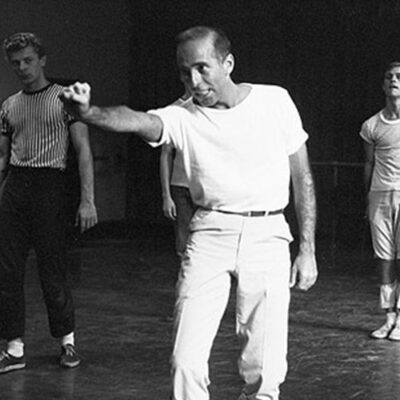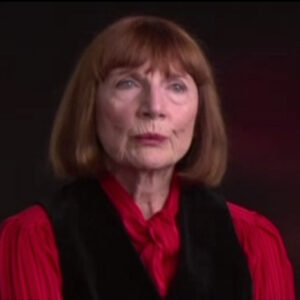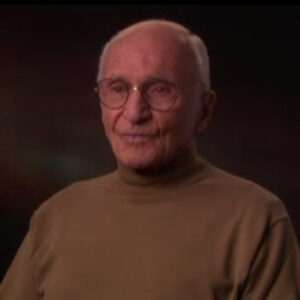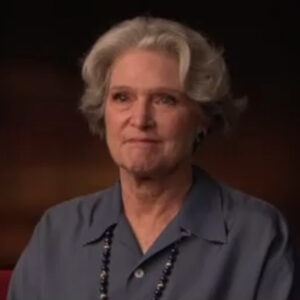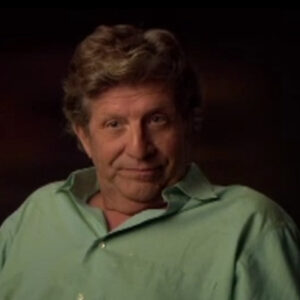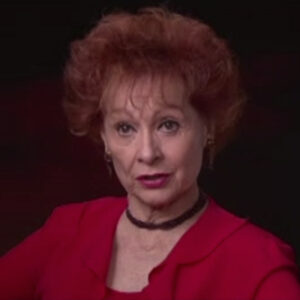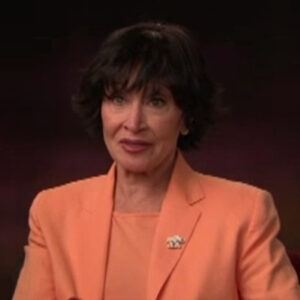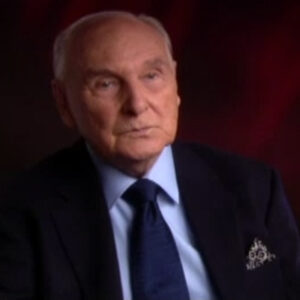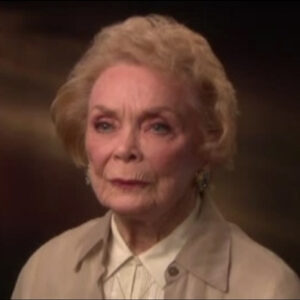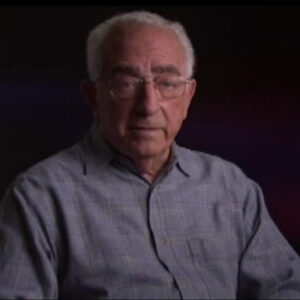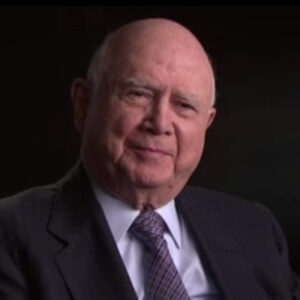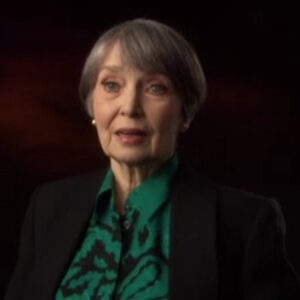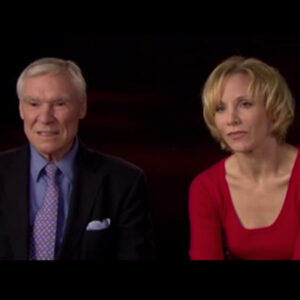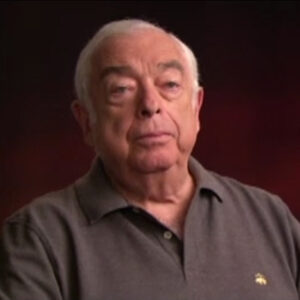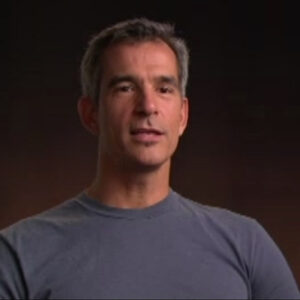Speaker The first time I met Jerome Robbins was with the Joffrey Company in the 70s. I was working as a production supervisor and he did movies or the company did movies and or we did movies. And Tom Skelton was the lighting designer for there. But I was responsible for the rehearsal of it. And I met Jerry then and we sort of hit it off. And and later the company did Interplay and another fantastic piece. And I did the light or recreated the light of Jean Rosenthal for that. So Jerry and I became sort of professionally involved at that time in the 70s.
Speaker And then you went somewhere with him?
Speaker Well, I I’m not quite clear whether we first did Dybbuk at New York City Ballet or during this time. Rubin Torontonian, of course, had sort of latched on to me as well. And so we went to Spoleto to do celebration, the art of the Partida, which I thought from Jerry’s part, was just totally brilliant. There were five couples representing five countries and they each did two partidos to sort from the standard repertory. And Jerry put together a an opening and closing. And the opening was just a procession with brightly colored banners. But the closing, I thought, was truly brilliant. They each in costumes from their own companies, did parodies both white and black from Swan Lake and one sort of bled into the other. Occasionally they were going on at the same time. It was really, truly brilliant. And for my part, the lighting, it’s one of the one of the things that I have lit in my life that thinking back on it, I can remember only one thing that I wanted to change. If I’d been able to change that, it would have been perfect.
Speaker Who, the one?
Speaker Oh, it was a color I wanted to change a color for one of the dancers and it was out of reach, so I couldn’t do that.
Speaker Now, you were in a place you were you mentioned already. Tell me about how Jerry felt about Spoleto and how I felt about him.
Speaker Well, all I know is that program that one summer when we were in Spoleto was just Jerry was brilliant. The dancing was fantastic. We were wonderfully treated. And later, several years after that, we went back again and did another program, which was not quite so brilliant, but it was still wonderfully received. And I think Jerry loved Spoleto and Spoleto. Italy is one of the most beautiful places in the world, a wonderful place to spend some time in the summer and to work.
Speaker He dedicated before we get to your own work, Jerry dedicated one of his greatest ballet dancers to a lighting designer. All right. I wonder if you can tell me who she was and what do you know about her relationship with Jerry?
Speaker Before my time, Jean Rosenthal was Jerry’s lighting designer. And I think in his early years she did everything. And she was a wonderful, wonderful person. She had a lot of savvy, theater savvy as well as knowledge about light. And so I think she was a great guide for Jerry in his early years, both in in Ballet’s USA as well as his Broadway work, and then later his his stances for companies, you know, for New York City Ballet in particular.
Speaker And I do know Jerry over time asked me to rely relight a lot of his dances. And one of them was the afternoon of a Faun and which had originally been lit by Jean Rosenthal, and the set had been designed by Jean Rosenthal. It sort of gave me pause. I knew that the lighting had sort of gotten out of joint over time, but I didn’t want to wade into that. But it was Jerry and I always did what Jerry asked me to do. So I tried. We spent maybe an hour and a half or two looking at different lights. And finally he said, no, there’s nothing as good as what we had. So we went back to the original and it was jeans. And I was happy to keep it that way.
Speaker Why you’re mentioning the values that you’re. What do you think it was about you that enabled Jerry to trust something wasn’t easy for him to trust you with some of his greatest values to.
Speaker Well, he had a good eye, and I think I have a good eye, and he called me Buddha, meaning that I was very quiet and thoughtful and willing to to go with his suggestions and his needs, occasionally it got us into trouble. I can remember. And one occasion at the Paris Opera Ballet, we were doing Four Seasons. And just even after the last rehearsal, he came and he said, you know, I think it’s just too dark. And so he had me put more light and more light and more light, and I kept resisting.
Speaker But finally, at the performance, it was clear to me that there was too much light because I knew the balance of the costume color with the background color was not right. It when the light is right, that color is equal. And because there was so much light on the dancers, the costume color was not right. So I’ve always said to the Paris Opera ballet, if they redo that dance, I want to be there.
Speaker They haven’t so far. But for the most part, I think, you know, Jerry and I saw the same thing, so we got along very well.
Speaker But what was it about him that caused you to sort of go his way instead of exercising your own better judgment?
Speaker Well, I thought the dancers were brilliant, you know, and I always feel that choreographers should have what they want and some choreographers get involved and others don’t. And Jerry was very much involved.
Speaker How can you give me some evidence of that in addition to what you just.
Speaker A light is very was very important to Jerry, and I think probably the best example of that is the time we spent together doing Jerome Robbins Broadway, which were excerpts of musicals that he had done basically. And we spent like seven weeks both taking it and previewing it. And, you know, he would come up to me and he’d say, know he was he was very good to me during that time because we would have a tech production meeting after a performance, you know, and he would say everything in public that was on his mind. But then at the end of that, he’d call me over. And one night he came and he said, you know, I think what are you are you doing something to the light? It’s just too dark. And so I said, no, Jerry, of course I’m not doing anything. And so but the next day, we went over everything and made it just the way he felt it should be. Lt was important to him because what was important to Jerry, I think was telling a story. The story could have been abstract and you know, it didn’t have to be literal and linear, but it was a story and the light revealed the story. And if the light wasn’t right and you know, there were many things that we agreed about. I tried in West Side Story in the section of West Side Story, in the dancehall there, three couples dancing. And I tried to put them in down lights. I don’t use down lights in my work usually because it’s not nice for bodies, for faces, it strange shadows and such. And Jerry saw those three down lights and I put the three down lights on them to isolate the three couples, one from the other. And he saw that and he said, no, no, no, turn it off, you can’t do that. So he had a very good eye and he knew what was going on. It was very light, was very important to him.
Speaker Why was the down lights wrong?
Speaker Because they lit the down lights were a lot wrong, because they lit the dancers in strange and awkward ways and he didn’t want any part of it.
Speaker How much did he know before a project about what he wanted to see in terms of the money and how would he express that to you?
Speaker He did not really express much. We worked we worked a good way together, I think, because I would put light on the stage and then we would talk about it. He would say it was too bright, it was too dark. It needed to have more side light. There needed to be more contrast. The color was wrong, the color was right, et cetera, et cetera. So it’s the best way to work with the lighting designer, I think, is to really be talking about the actual light rather than trying to predict what it’s going to look like before looking at it.
Speaker So before you began to work, did he talk to you about the ballet?
Speaker He very definitely talked to me about the ballet before we started work, but it was often about the ballet, mostly about the ballet. And, you know, often he would get interested in paintings and talk about the light in the paintings, but he never expected that light to be put on the stage. He he understood that the stage light is of itself and not trying to copy something else.
Speaker Give me an example where that happened. I started with some sort of visual reference. No, I can’t remember the name of the painter. I bring you some sketches because you know what?
Speaker I remember primarily where the sketches of Santo Licastro, who did the, uh, the scenery and costumes for the Four Seasons, and Jerry and Santo and I talked about specific lighting and about color primarily, and how the three of the the four sections would be different from each other with respect to color, with respect to intensity. But here again, I primarily remember the work changing on stage during technical rehearsals and lighting rehearsals rather than beforehand.
Speaker He talks in his writing about his you. It’s been it’s been very slight. Let’s just cut for a second catwalks and his writings about the importance of finding a visual style for each piece. And I’m wondering, based on your experience, if you can tell me what he meant by that and how did it.
Speaker Well, I think, first of all, I’m sure that in the studio he tried to find specific movement for each piece and then with often with the designers, he tried to find a visual. Look for a piece, interestingly enough, I don’t know that he succeeded all of the time, I think he may have begun with that, but he often instead of. You know, maintaining a specific look, a special look for each piece, he would pair it away and pair it away like the costumes, and so that they often did end up looking more or less the same. But but still, the flavor of them was always, you know, left from the way he started here, you know, how said that.
Speaker And again, I read somewhere that Jerry was the first director he worked with who used the lighting designer. Um, presuming that’s true, um, I mean, does that sound plausible to you? And what does that tell you about Jerry?
Speaker Oh, I have not heard that Jerry was the first director to use a lighting designer, but I can believe that it was true. I assume that means director for stage work as opposed to dance. And certainly I think it was Jean Rosenthal. You know, Jean Rosenthal worked with Martha Graham, worked with Jerome Robbins, worked with Balanchine, I think. And she was very much a part of everything that she did. It wasn’t just supplying the lighting. She was a guide to how theater was done. And so I think Jerry must have come to depend on her in his dance work a great deal. And so when he did stage work, he also depended on her and she became a partner in the work, I’m sure.
Speaker And what if that pioneering amendment was so important to him? What does that say about his eye? You talked a little bit about his eye for tell me about that and how detail oriented he was.
Speaker Well, Jerry had an eye for all the detail. And, of course, what reveals the detail is the light. And so the light was always at his right hand and designers were very, very important to him. And I think that’s probably why he latched on to me so quickly after the first time we met.
Speaker How about for colored? He.
Speaker Color and light for Jerry, I think, was more or less to reveal the color on the stage, one of the most the richest colored pieces that we did was I can’t remember the name of it at the moment, the Greek antique epigraphs. But the color in that came from the psych and from or the background and from the costumes and the light. The color in the light was just there to show that color in the costumes to the best.
Speaker In the best light, what did you tell you about that piece before you lit it? I mean, it’s oh, absolutely.
Speaker But he only told me that it was about the poems and, you know, and I read the poems and and and Jerry, he that was one of the pieces that I always felt this, that he changed the order at the last minute. So I lit it in a different order and then he changed things around. So I always felt that it was a little hiccup, that the flow of the light was not the way that I would have wished. But he, of course, was telling his story and that so it was important to him to have it in the right order for him.
Speaker OK, um, as a project progressed, how closely did he stay involved in the details? I mean, was he involved in sort of the technical aspect with you or.
Speaker He wasn’t involved, he was never involved in focusing or things like that, though he would often go on stage and look up and say that light is not on or that light is not on. But he did not you know, he was not technical in that sense. But of course, he was with the company. He stayed with the dance longer than I did. And therefore, whenever I came back to revisit a dance, I would find that it had changed. So with him, it was always growing and always changing, and he was always trying to find the way and which, you know, I’m perfectly happy if the choreographer is with the company and the company has people who are in charge of the lighting, I’m perfectly happy for the light to change according to their wishes. Mainly, it was made brighter for Jerry.
Speaker Did you find that happened as he got older, I mean, maybe it’s a function of cataracts or something?
Speaker Yes, I you know, I just feel lucky myself that I think I have not suffered as I’ve aged. I still am able to see well, but I certainly know it happened with Balanchine and I think with Jerry as well that as he and some days he was tireder than others and therefore saw less well.
Speaker Could you you know, I think I made the point, but it didn’t you responded to it, but you’re exactly right.
Speaker Um, uh, what was the question again?
Speaker Do you find that as he got older?
Speaker I know that that Jerry, as he got older, did probably not see as well as he once did there. It happened, I know, with Balanchine and it and it probably happened with Jerry as well. There were some days when he was tired and he didn’t see as well on those days, I’m sure, as other days. And I think that was true that night with Jerome Robbins Broadway, when he took me aside and said, what have you done to the lighting? It’s so dark. I think he was just tired that night.
Speaker OK, um, how would you describe Jerry as a collaborator?
Speaker Jerry is a collaborator that I never would really think of using that word with Jerry. I don’t think he was a collaborator. He had a very definite view of his work and the way he wanted it to be seen and to be presented. And so that was true for dancers. It was true for designers. It was true for as much as possible for composers. But it was his work, most definitely.
Speaker Given that, do you think he did or did not get the best out of you and why?
Speaker I think that Jerry did get the best out of me, though I have been present when I knew that he was not getting the best out of the set designer or out of the costume designer. And it may be that, you know, I had my Jerry way of lighting and it may be that if I had been on my own, I would have lit the pieces differently. But I can’t say that they would have been better or better lit.
Speaker Why do you think your experience with him was different than with costume and set designers in general?
Speaker I think because. I think my experience was different with Jerry from that of a set designer, a costume designer, because my ego is such that I can sublimate it or and I think that’s why he called me Buddha as well. I didn’t have to prove anything to Jerry, and I was perfectly happy to to, you know, give him his peace and have as little of it of me in it as possible.
Speaker So you think what you’re saying then is it’s a personal matter as opposed to the disciplines of certain costume design and lighting design? I don’t think there was anything involved in.
Speaker Yes, I know, I think I truly think that it was a personal thing, and I think because I’ve seen him working with other lighting designers and who did want to make their mark, you know, who did want to leave their signature on the piece, if you would. And I didn’t care about that, so.
Speaker You were quoted in Amanda Vail’s book, her biography, as saying that Jerry felt he was here’s the quote was always right.
Speaker That manifests itself in his work relationships.
Speaker Well, the jury did feel that he was always right and it didn’t mean that his first choice was always right. I mean, he agonized over many things. And do we do it this way or do we do it that way? Do we do it in this order? Do we do it in a brightly lit? Do we do it dimly lit? Rarely dimly lit? I might say. But so he explored. But he he was he was right. He made the right choices. He and I think that it comes back to telling the story. He always found the way to make the line clear.
Speaker So what do you attribute the fact that he wasn’t more decisive sooner, given that he seemed to know what he wanted?
Speaker I think yes, I think life was ambiguous for Jerry Robbins and that his choices always sort of reflected that that he had he gave himself many possibilities because he knew that he would need the many possibilities to have a final rich choice.
Speaker I’m going to have to cough, so maybe just cut off, because you were I don’t remember.
Speaker I forgot what I was saying.
Speaker Oh, well, that’s OK. What I had asked you was given the fact that Jerry pretty much knew what he wanted. Why? What do you attribute the fact that he wasn’t more decisive sooner?
Speaker Yes, well, Jerry Robbins was ambiguous in his life, I think, and he gave himself many possibilities and it simply made the final choice very rich that he had so many possibilities to choose from.
Speaker You started to talk before about the debate. What if you can tell? I think that’s the first original production we did together. And it was a little bit fraud, forgery, something you drive more than once. Tell me about that.
Speaker Yes. Well, for me, it was for me the Dybek was totally thrilling because it was working with two fantastic giants, if not three. I mean, with Reuben Torontonian thrown in, but Jerome Robbins and Leonard Bernstein, it was a fantastic experience for me, I must say, in those days, you know, lt was difficult and the set up at New York City Ballet was very difficult. There was just not much of it in the first place. And the DABIC was a major piece and it had many needs, but there was not the possibility to add a lot of lights to the repertory to supply the necessary light for the piece. So I really had to patch things together. So that was extremely frustrating, but. The wonderful end of that story is I’ve gotten to go back to the Dobek now and related and light it the right way, and I think this last time at New York City Ballet was what Jerry would have wished.
Speaker I don’t know how much you a witness to the collaboration between Bernstine and Jerry, but. It was kind of fraud. What do you remember about that?
Speaker I only remember that.
Speaker Jerry and Lenny were finding it very difficult to work together, they seem to be wanting different things from each other and it certainly made the time in the theater quite fraught. And it may well be why the piece never totally worked in Jerry’s mind.
Speaker Do you remember the nature of the fundamental nature of their disagreement? No.
Speaker What did I tell you that he wanted from the peace before you ruin it?
Speaker Once again, Jerry did not speak very specifically about the light in the piece before we were actually on the stage. I mean, I like I like to light very specifically, and it was clear to me that these sections needed to be lit that way. And it was frustrating because the light wasn’t there with the New York City Ballet set up to do exactly that, so that we did have some awkward times in lighting it. But in the end, I think we were relatively pleased with the outcome.
Speaker Um, you talk a little bit before about antique epigraphs, and I wonder if, Jerry, did you share his homework with you and maybe we can relate that to that piece because I know he did some right now.
Speaker He didn’t really other than the poems other than and, you know, and Freese’s and, you know, he may have shown me some some research. Pictures at the time, 4:00 a.m. for, you know, for Greek and and the poems of the Greek and the poems of Sappho, but he did not. Really share with me all of his process.
Speaker Was he somebody or was he not who did homework and who would refer to.
Speaker Other pictorials sources to me, he never referred to other pictorials, sources or other visual sources, but I know that Jerry was constantly going to see other people’s work and going to museums and going to galleries and listening to music. And so I think that his you know, there was there were also always a richness of source, if you would, in his in his life.
Speaker Was there anything that he told you about and to get across before you put it in terms of creating some sort of a community of these women? Not really, not really to the dance you went and did it and he said yes.
Speaker OK, in memory of what happened at a very difficult time in the company’s history, what do you remember about Jerry state of mind during that project? And what did he tell you about?
Speaker Once again, he didn’t tell me anything about in memory of, but he was he was definitely. Quieter, more meditative at that time and. With Gerri, though, it was always first one thing and then the other. I mean, you know, he was quiet and then he was over active and shouting and and frustrated and then much more quiet than usual, though, during most of the process. So clearly, it was extremely moving to him and he wanted it to be just right. So the frustration that came with when it wasn’t just right sort of boiled over, but mostly he was somehow extremely moved by it.
Speaker Um, did you say a memorial? I did. OK, thank you for remembering. I forgot.
Speaker Um, another one of what I think of is to say goodbye, Dallis was the Ive’s piece. Do you see sort of any correlation between that peace and Jerry, where Jerry was in his own life? And if so, could you tell me about that?
Speaker The Ives piece was very, it seemed to me, autobiographical somehow for Jerry and. Oh, you know, I did not know him well enough personally to know what was going on in his life at any given moment, but it was clear to me that he lived his life through his dances, through his choreography, so that I just assumed that the pieces that were interesting to him and that that he was making at the moment really did reflect the fact that he was thinking back, the fact that he was remembering the fact that his life had been peopled by people who were no longer there. It was very clear to me in. The I’ve Speace.
Speaker You also the that you do for Michelle, and I imagine that was pretty straightforward suite of dancers, but I wonder if you can tell me something about the nature of their relationship.
Speaker Yes. Well, I think Misha Baryshnikov adored Jerry and thought that he was an extraordinary choreographer. And I think the fact that Jerry made a piece just for Misha was made Misha very proud. And he he danced it just beautifully. And as always, I have found when people are particularly moved by something, they do it very well. And to me that some of the best dancing that Misha has done.
Speaker Tell me what Jerry talk to you about when he first explained to you about Jerome Robbins Broadway. What did he tell you he was hoping to do and why it was important to him?
Speaker Well, he was very excited, Jerry was very excited about doing Jerome Robbins Broadway because it was a chance for him to revisit a lot of his past and in a way that once again, he could put the whole story together, the whole history together. And he made it very clear to me, though, that he did not want the light to and he didn’t have to tell me. I knew that he didn’t want the lighting from the 20s, the 30s, the 40s, the 50s that he wanted the lighting for from the moment. But it was interesting because I at one point I told him that I was busy at one of the time, you know, part of the time doing the production. And so he said, OK, well, I guess you can’t do it, which upset me very much. But I had a prior commitment. And so there was a while there that I wasn’t doing it. And finally Jerry came to terms with my not being there for that. It wasn’t a very important time. And so he came back to me and he said, yes, well, I do want you to do it. I understand you have the commitment. We’ll work around that. So it was a time that was really kind of emotional for me as well as for him. And it was just great to be there when he was so excited about a project.
Speaker And how is it different than writing, Ali? His other work?
Speaker Well, it was different because each piece needed its own kind of style of light. I mean, certainly not the original way, but it still needed its own way. And it was great. It was great for me to see all this work that I hadn’t I hadn’t been in New York when most of it was done. So it was great for me to see the work and to sort of live that moment and find an expression of it in in the light. And and I found that obviously Jerry commented on the light, but I found it for myself and for him. So it really was very much mine.
Speaker What was your assessment of the peace, finally?
Speaker I loved it, but I think it was probably a bit too complicated for the time. I know Jerry was extremely upset that it didn’t work better with audiences, but I think personally that that there was probably just too much that happened too quickly to really relish that. He felt strongly about the story of it. And he worked very hard to make it, to give it a line and give it a story. But I think in the end, audiences found no one to really care about in it to identify with. So they so they didn’t come in the droves that he hoped they would go.
Speaker Still ran a few years, it, um, you know, I wonder if you could give me the same idea, but in such a way that a person who didn’t see the show would understand why that was the case. Do you know what I mean? I mean, that’s that’s what he was famous for, basically was telling a story, you know, and unifying all of the elements and putting everything in service of the storytelling.
Speaker And he kind of deprived himself of being able to do that by having this story in that story. Right.
Speaker Yes, and Jerome Robbins, Broadway. I think that it did not work as well as it could have because there were little bits and sections of so many musicals that in the end, Jerry was not able to make a story of them. That or certainly not to have someone who the audience identified with be a part of each of them and therefore tell a story about them. And I’ve always felt that if it had been a little simpler, maybe if there hadn’t been so many pieces, that it could have been a bit more successful.
Speaker Great.
Speaker I’m going to cough again, right?
Speaker You said it is memorial that he could I’m quoting you take a gesture or a note or a step or a word.
Speaker And make a clear story. I wonder if you could repeat that and tell me what you mean and give me an example.
Speaker OK, yeah, I don’t know that I can. Yeah, I don’t know that I can remember all those words that I said, but do I mean to say to her.
Speaker Yeah, she said he was so lovely now, but you said he could take a gesture or a note. Or a step or word and make a clear story.
Speaker Jerry could take a step or a note or a word or a gesture and make a clear story from it. He understood the humanness of each of those things and how it related to all of us and to him, that was what was important, the story. So you make a gesture and he. Reads into it or reads it in a way that is a story, and he can put one thing after the other and make the story very moving.
Speaker I’m wondering, since you are a designer, if Jerry ever I think I know the answer, but did he ever show you any of his own artwork?
Speaker No, Jerry never showed me his own artwork. He did. He did. There was a wonderful afternoon I had at his house when he showed me the little Binswanger notebook that he had, which was just beautiful. But that’s about as close to his artwork as we got.
Speaker Um, what was your favorite project in Robin’s project and why?
Speaker It’s very difficult to name a favorite project of Jerry’s. For me, I, I love them all and I love them each in in different ways. Maybe maybe it’s a it’s a performance of well, there, too. I mean, it’s it’s the Chopin. I didn’t even do them originally dances at a gathering and in the night, both done by the Paris Opera Ballet. And I did the lighting for them there. And there was one afternoon when I was lighting and we just had a lighting rehearsal and the company dance dances at a gathering like I have never seen it done. And I couldn’t. It was just a rehearsal. I couldn’t imagine why. And then I realized it was the first time that Jerry had seen it in a year. He had come to look at it. And so they were dancing it for him and it was just to die for. And in the night, the the that company, the Paris Opera ballet dance, that just exquisitely as well. So it’s not it’s those performances, those particular performances that I remember that are my favorite, I think.
Speaker You’ve worked you’ve lit a lot of valleys in your life. How was working with Jerry different from other choreographers whose values you’ve worked?
Speaker Well, I think even to the end that my behavior with Jerry was different from working with anybody because I was in awe of him, even even though I felt myself a close friend at the end. I still I think he was a fantastic choreographer and I was just thrilled to be a part of his dancers. I learned a great deal from Jerry about making theatre, about loving theater, about truly respecting the people. You know, he had a hard life and he did a lot of yelling and abusing of dancers and designers and so on and so forth. But deep inside of him was a great love for theater and for dance. And that to me was what was important. That was I’m sure it was important to him. And he is sort of imbued in me that love as well.
Speaker Now, I think you are familiar with the Jerome Robbins Foundation. Please tell me what that is. And what what they do, what they give grants for.
Speaker Yes, I am always Gerri is close to me, always even today, because through the Jerome Robbins Foundation, his pieces are being done. Throughout the world, and I am responsible for the lighting for each of those pieces, and I rarely manage to go to all of these places, but I do have young lighting designers who go and do the work for me, who I recommend. And it’s just very exciting to me that Jerome Robbins work does last, does keep going throughout the world. And I’m you know, I can’t wait till I see dances at a gathering next May with the Royal Ballet in London.
Speaker Yes. Um.
Speaker Um, and finally, did you aren’t you a grant recipient tell me about what the foundation does in that regard, what they.
Speaker I think it’s 2003 wasn’t. I think well, in 2003, I was thrilled to receive the first Jerome Robbins prize and even more thrilled to hear that Jerry had said that I should be the first recipient of the Jerome Robbins prize. So it it it made me very proud and and thrilled to be a part of it.
Speaker And what’s the purpose of the prize?
Speaker It’s I don’t know. I’m sure there’s something specific that the prize is, is, you know, that there are words that it says, but it’s it is true at that same time, it was given to the New York City Ballet. So each time it is given, it is given to an individual and to a company or to people who support the ballet and who bring their work to embellish the work of a ballet company.
Speaker Is there anything you’d like to tell me about your work with Jerry?
Speaker I don’t think so. It’s very interesting to me, though, every time I go to New York City Ballet and work, I somehow see Jerry sitting in his red sweater in several rows in front of me, watching the piece, making sure I do it right. So he’s with me always.

